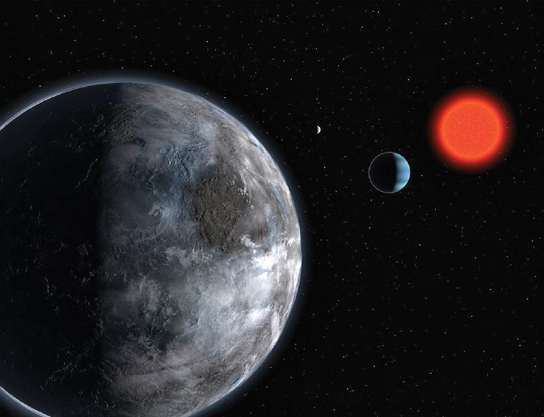2007
Habitable Super Earths?
The discovery of planets around other stars has naturally led to excitement and anticipation about potentially discovering other Earthlike worlds in our celestial neighborhood. The prospects have been daunting, however, as the first extrasolar planets were discovered around an exotic, high-energy pulsar supernova remnant, and most of the subsequent discoveries of planets around main sequence stars have been “hot Jupiters,” massive gas-giant worlds orbiting extremely close in to their parent stars. More recently, some so-called super Earth planets (ranging from a few to 10–15 times the size of our world) have been discovered, but again, most are very close in to their parent stars.
In 2007, however, two members of a new class of planet were discovered—potentially habitable super Earths—among the system of at least six planets orbiting the star Gliese 581. The newly discovered planets, known as Gliese 581 c and d, are now inferred, based on radial velocity variations of the host star, to be around 5–10 Earth masses. Most important, these two planets orbit within Gliese 581’s habitable zone—the distance from a star within which an Earthlike planet could maintain liquid water on its surface. In our solar system, the habitable zone extends from about Venus to Mars.
There is, of course, no guarantee that planets like Gliese 581 c and d, or others since discovered to orbit within their star’s habitable zone, are actually habitable (or inhabited). The concept of the habitable zone merely acknowledges that life as we know it requires liquid water for its formation and sustainability. If these worlds are bathed in harmful radiation from intense solar flares, are heated to the melting point by tidal interactions with their star or with other planets, or have all their water tied up as frozen ice, then they might not truly be habitable. In addition, examples from our own solar system, such as Europa, Titan, and Enceladus, show that it can be possible for habitable worlds to exist outside the traditional habitable zone, if other energy sources are present that can help to keep liquid water stable on or under their surfaces. So far we know of only one perfect, “Goldilocks” planet for life as we know it—Earth. Many astronomers expect that soon, however, Earth 2.0, and others like it, will be found.
SEE ALSO Earth (c. 4.5 Billion BCE), Europa (1610), Titan (1655), Enceladus (1789), An Ocean on Europa? (1979), First Extrasolar Planets (1992), Planets Around Other Suns (1995), Life on Mars? (1996), An Ocean on Ganymede? (2000), Huygens Lands on Titan (2005).
An artist’s impression of the planetary system around the red dwarf star Gliese 581. The system includes at least three “super Earth” planets with masses from five to fifteen times that of Earth, two of which might orbit in the so-called habitable zone around the star.
